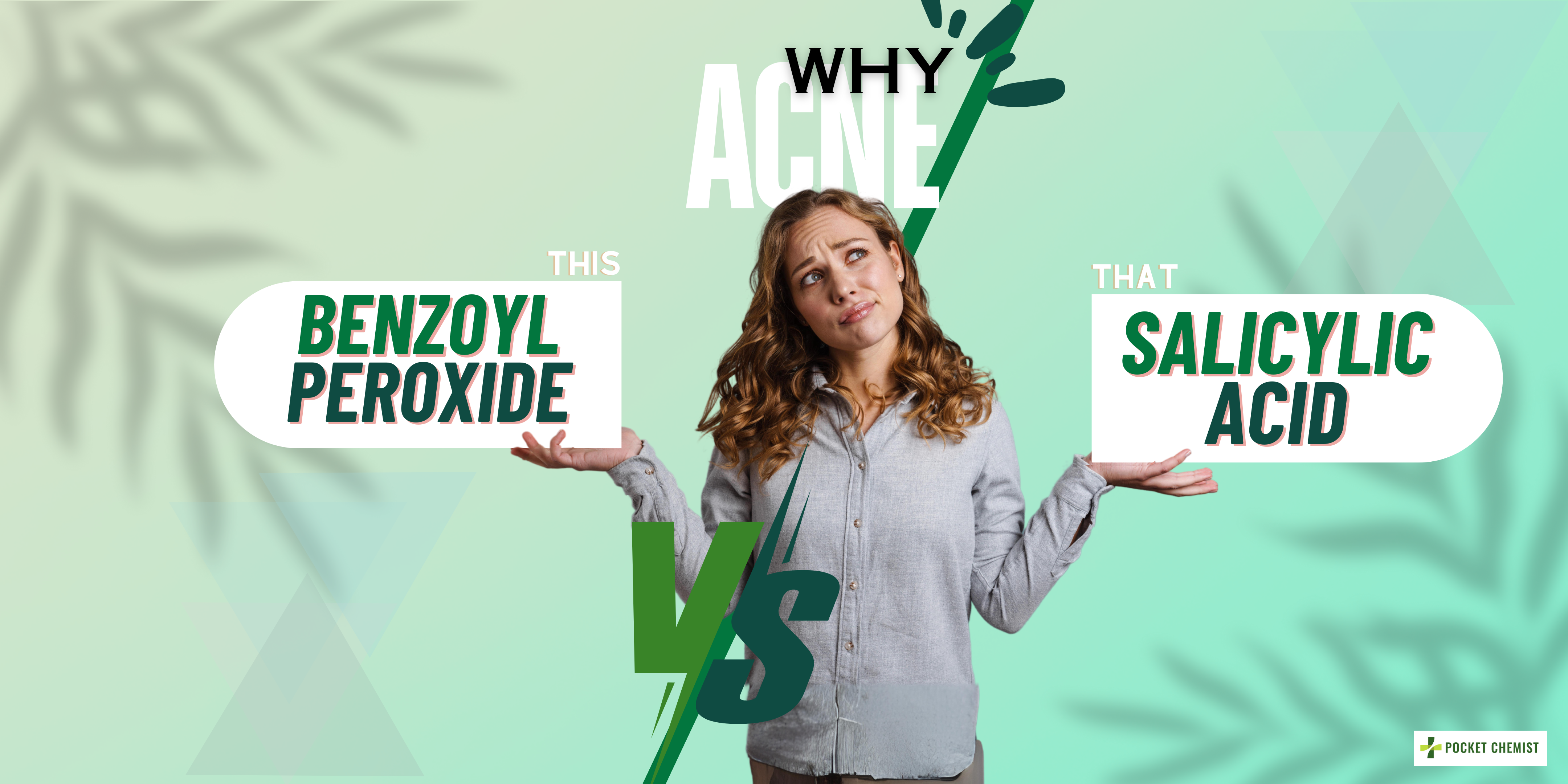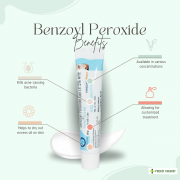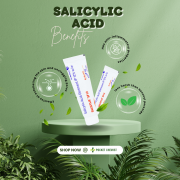Benzoyl Peroxide vs. Salicylic Acid: Which is Best for Acne?

Acne is a common skin problem faced by almost every teenager to adults around the globe. It can be hard to figure out which acne treatments are best for you. With a variety of products available, it’s hard to know which one is right for you.
Two of the most common ingredients are benzoyl peroxide and salicylic acid. But which one is the best for acne treatment?
In this blog, we’ll get into the specifics of these two powerhouse ingredients. We’ll explore how they work, their pros and cons, and how to use them effectively.
Whether you’re a teenager battling your first breakout or an adult dealing with persistent acne, this guide is for you.
After you read this blog, you’ll have a good knowledge to make an informed decision about your acne treatment.
Understanding Acne and Its Causes
Acne is a common skin condition that occurs when your hair follicles become clogged with oil and dead skin cells. It often leads to whiteheads, blackheads, or pimples.
But what causes acne?
There are several factors that can contribute to the development of acne:
- Excess oil production: When your sebaceous glands produce too much oil, it can clog your pores and lead to acne.
- Dead skin cells: These can accumulate in your pores and cause breakouts.
- Bacteria: Acne-causing bacteria can thrive in the excess oil and dead skin cells, leading to inflammation and pimples.
- Hormonal changes: Fluctuations in hormone levels, especially during puberty or pregnancy, can trigger acne.
- Certain medications: Some drugs, including certain corticosteroids, androgens, or lithium, can cause acne.
Understanding the causes of acne is the first step towards finding an effective treatment. In the next sections, we’ll explore how benzoyl peroxide and salicylic acid can help combat these causes and clear your skin.
Benzoyl Peroxide for Acne
Benzoyl peroxide is a common ingredient in many over-the-counter acne treatments. It’s a powerful agent that can help clear your skin and prevent future breakouts.

How Benzoyl Peroxide Works
Benzoyl peroxide works by killing the bacteria that cause acne. It does this by introducing oxygen into the pores, which is lethal to the acne-causing bacteria.
In addition to its antibacterial properties, benzoyl peroxide also helps to dry out excess oils on the skin. This can help to prevent the clogging of pores, which is a primary cause of acne.
Pros and Cons of Benzoyl Peroxide
Just like any other acne treatment, benzoyl peroxide has its pros and cons.
Pros:
- Effective at killing acne-causing bacteria.
- Helps to dry out excess oils on the skin.
- Available in various concentrations, allowing for customized treatment.
Cons:
- Can cause skin irritation, redness, and peeling, especially at higher concentrations.
- Can bleach clothing and towels.
- Can make the skin more sensitive to sunlight.
Despite having cons, many people find benzoyl peroxide to be an effective acne treatment. However, it’s important to use it correctly to minimize side effects.
How to Use Benzoyl Peroxide Gel
When using benzoyl peroxide gel, start with a lower concentration to see how your skin reacts.
You can gradually increase the concentration if your skin tolerates it well.
- Apply a thin layer of the gel to the affected areas once or twice a day.
- Be sure to avoid the eyes, mouth, and other sensitive areas.
Remember, consistency is key and It may take several weeks of regular use to see significant improvements in your acne.
Salicylic Acid for Acne
Salicylic acid is another popular ingredient in acne treatments. It’s a beta-hydroxy acid that can help to unclog pores and reduce inflammation.

How Salicylic Acid Works
Salicylic acid works by exfoliating the skin. It helps to remove dead skin cells that can clog pores and lead to acne.
In addition to its exfoliating properties, salicylic acid also has anti-inflammatory effects. This can help to reduce the redness and swelling of pimples, making them less noticeable.
Pros and Cons of Salicylic Acid
Just like benzoyl peroxide, salicylic acid has its own set of pros and cons.
Pros:
- Effective at exfoliating the skin and unclogging pores.
- Has anti-inflammatory properties.
- Generally considered less harsh than benzoyl peroxide.
Cons:
- Can cause skin irritation and dryness.
- Can make the skin more sensitive to sunlight.
- May not be as effective for severe or cystic acne.
Despite having cons, many people find salicylic acid to be an effective acne treatment. However, it’s important to use it correctly to minimize side effects.
How to Use Salicylic Acid on Face
When using salicylic acid, start with a lower concentration to see how your skin reacts.
You can gradually increase the concentration if your skin tolerates it well.
- Apply a thin layer of the product to the affected areas once or twice a day.
- Be sure to avoid the eyes, mouth, and other sensitive areas.
Remember, consistency is key. It may take several weeks of regular use to see significant improvements in your acne.
Comparing Benzoyl Peroxide and Salicylic Acid
Now that we’ve looked at both benzoyl peroxide and salicylic acid, let’s compare them side by side. Both ingredients can be effective for treating acne, but they work in different ways and may be better suited for different types of acne.
Benzoyl Peroxide:
- Kills acne-causing bacteria.
- Dries out excess oils on the skin.
- Can cause skin irritation, redness, and peeling.
- Can bleach clothing and towels.
Salicylic Acid:
- Exfoliates the skin and unclogs pores.
- Has anti-inflammatory properties.
- Can cause skin irritation and dryness.
- Generally considered less harsh than benzoyl peroxide.
Which Should You Choose for Your Skin Type?
Choosing between benzoyl peroxide and salicylic acid largely depends on your skin type and the type of acne you have.
Benzoyl peroxide is often recommended for inflammatory acne, such as red, swollen pimples and pustules. On the other hand, salicylic acid is typically used for non-inflammatory acne, like blackheads and whiteheads.
Remember, everyone’s skin is different. What works for one person may not work for another. It’s always a good idea to consult with a dermatologist if you’re unsure about which acne treatment is right for you.
Building an Effective Skincare Routine
A good skincare routine is key to managing acne. It’s not just about the products you use, but also how you use them. Consistency is crucial.
Start with a gentle cleanser to remove dirt and excess oil. Follow with a toner to balance your skin’s pH levels.
Finish with a moisturizer to hydrate your skin. Even if your skin is oily, don’t skip this step. Hydration helps maintain a healthy skin barrier.
Incorporating Acne Treatments into Your Routine
When incorporating acne treatments into your routine, start slow. Introduce one new product at a time to see how your skin reacts.
If you’re using benzoyl peroxide or salicylic acid, apply it after cleansing but before moisturizing. Remember to start with a lower concentration and gradually increase if needed.
Lastly, always wear sunscreen during the day. Acne treatments can make your skin more sensitive to the sun. Protecting your skin can also help prevent post-acne dark spots and scars.
Alternative Acne Treatment Options
If benzoyl peroxide or salicylic acid doesn’t work for you, don’t lose hope. There are other acne treatment options available.
Retinoids, for example, are a popular choice. They work by increasing cell turnover and reducing inflammation. However, they can be harsh on the skin and are usually used under a dermatologist’s guidance.
Natural remedies, like tea tree oil and green tea extract, can also be effective. They have anti-inflammatory and antimicrobial properties. But remember, natural doesn’t always mean safe.
Always do a patch test before using a new product.
Final Thoughts and Next Steps
In the battle of benzoyl peroxide vs. salicylic acid, there’s no clear winner. The best acne treatment depends on your skin type, the type of acne you have, and how your skin reacts to different ingredients.
Remember, treating acne takes time and patience. Don’t expect overnight results. It’s important to stick with your skincare routine and give products time to work.
If over-the-counter treatments aren’t helping, it may be time to consult a dermatologist. They can provide personalized advice and prescribe stronger treatments if needed. Don’t let acne control your life. Take the next step in your acne treatment journey today.

